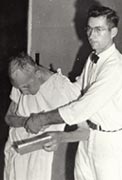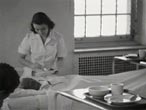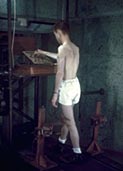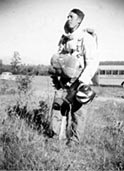|
Alternative Service
The majority of men who performed alternative service during the war were interned in 152 Civilian Public Service camps across the country. Most men were housed in the barracks of former Civilian Conservation Corps or Forest Service camps, where they worked at hard labor planting trees, fighting fires, building roads and constructing dams in remote locations. Others built sanitary facilities for hookworm-ridden communities, ran medical clinics in areas of rural poverty, cared for juvenile delinquents, conducted agricultural experiments and worked on soil conservation projects. The men wanted more meaningful work, the "work of national importance" they had been promised by law. After several years in the camps they were finally allowed detached service as attendants in mental hospitals, guinea pigs in medical experiments and smoke jumpers fighting fires in national parks.
| |
 CO Erie Kindy assists patient at Marlboro State Hospital in New Jersey
Photo: Mennonite Central Committee |
Mental Health Reform
Perhaps the most significant long-term contribution of COs to the national welfare was their work in 41 mental institutions in 20 states, and at 17 training schools for "mental deficients" in 12 states. By 1942, most of the employees in mental facilities had left for better-paying jobs in war industries. Their jobs were filled by 3,000 COs. In response to the draconian conditions they found in these institutions, CO's introduced nonviolent methods of patient care, won a lawsuit against the state of Virginia for humane treatment of patients, founded an organization that became the National Mental Health Foundation and in 1946 brought national attention to the issue with a shocking Life Magazine exposé.
| |
 COG at work in mental hospital
|
Conscientious Objector Girls
COs were joined in the hospitals by many women, including wives of COs and nearly 300 pacifist co-eds who call themselves "Conscientious Objector Girls" (COGs). The COGs helped change Eleanor Roosevelt's opinion of Civilian Public Service. Previously, she had written in her newspaper column, "The conscientious objector is not performing any service for the country." After a visit with the COGs, Eleanor wrote that the COs working in the mental hospitals improved standards dramatically. Roosevelt's contacts with the COGs led her to work with members of the historical peace churches and sponsor the new National Mental Health Foundation in the postwar years.
 CO participates in cognitive experiment
| |
Human Guinea Pigs
Nearly 500 COs competed to volunteer as guinea pigs in dangerous and life-threatening medical experiments seeking cures for malaria, infectious hepatitis, atypical pneumonia and typhus. Some CO subjects were inoculated with live hepatitis virus.
We were very concerned of course that we had been called all kinds of names, yellow bellies, and things like that. I had volunteered for an ambulance driver and got turned down, American Field Service, they said they didn't want any more COs, they had too many, but I was young and I wanted to show that I was not a coward, so when they offered me this chance of being a guinea pig, it fit right in with my scheme of things of proving that I was willing to take risks on my own body, but I just did not want to kill someone else.
- CO Neil Hartman
Neil Hartman served as a human guinea pig and was repeatedly injected with live hepatitis virus. Former Surgeon General, C. Everett Koop, then a medical resident performed two biopsies on Hartman.
Other CO volunteers were covered with lice and sprayed with DDT, or subjected to high altitudes, extreme temperatures and lengthy periods of immobility. The starvation experiments conducted at the University of Minnesota were among the most dramatic test for the COs. Healthy, young men committed to the cause were reduced to angry and emaciated skeletons. The dramatic results of the experiments were so severe and long-term that they helped to inspire the Marshall Plan which, as a keystone of U.S. foreign policy, set a precedent for helping countries combat poverty, disease and malnutrition after the war.
CO Lester Glick kept a diary while participating in the starvation experiments. Read a selection from his diary entries.
 Smoke jumper
Luke Birky
| |
Smoke Jumpers
In 1942, the New Deal program Civilian Conservation Corps (CCC) was disbanded and the conscientious objectors took their place fighting fires in forests throughout the West. While the prevention and fighting of forest fires occupied nearly one-fourth of all CPS labor, the most elite, dangerous and desirable assignment for a CO was smoke jumping. Three hundred CPS men volunteered for this hazardous duty when the first group was formed in the summer of 1943. Luke Birky was among the first group of 60 trained at the Mennonite smoke jumpers camp near Missoula, Montana. By the end of the war, 240 COs had served in the program deployed as squads to base camps in Montana, Idaho and Oregon. Jumping into extremely rugged terrain and using methods barely out of the experimental stage, they parachuted directly onto newly spotted fires before they could rage out of control.
Many of us were wanting to do work that was significant and vital to the U.S. good, and smoke jumping was a new way of fighting fires. Many of us grew up in the West and had a great deal of concern about forest fires....It was a challenge, it was exciting, it was a little scary. I suppose also many of us had been labeled as "yellow bellies," cowards, for not wanting to go into the war and I assume, for some of us at least, there was a secondary motivation that we may have wanted to try to do tasks that might even be dangerous to show that we had courage also.
- Luke Birky, WWII CO
|
